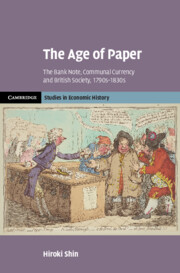Book contents
- The Age of Paper
- Reviews
- Cambridge Studies in Economic History
- The Age of Paper
- Copyright page
- Contents
- Figures and Illustrations
- Tables
- Acknowledgements
- Abbreviations
- Introduction
- 1 The Beginning of the Bank Restriction Period
- 2 The Users of the Bank of England Note
- 3 The Registers of Paper-Currency Use
- 4 Gold, Gold, Gold
- 5 The Forgery Crisis and the Radicalisation of Communal Currency
- 6 Resumption and Its Aftermath
- Conclusion
- Bibliography
- Index
5 - The Forgery Crisis and the Radicalisation of Communal Currency
Published online by Cambridge University Press: 19 December 2024
- The Age of Paper
- Reviews
- Cambridge Studies in Economic History
- The Age of Paper
- Copyright page
- Contents
- Figures and Illustrations
- Tables
- Acknowledgements
- Abbreviations
- Introduction
- 1 The Beginning of the Bank Restriction Period
- 2 The Users of the Bank of England Note
- 3 The Registers of Paper-Currency Use
- 4 Gold, Gold, Gold
- 5 The Forgery Crisis and the Radicalisation of Communal Currency
- 6 Resumption and Its Aftermath
- Conclusion
- Bibliography
- Index
Summary
Chapter 5 describes the dramatic changes of situation surrounding paper currency in post-war Britain. It focuses on the forgery crisis of 1818, which significantly undermined public trust in the Bank and its notes. Forgery became an acute problem after 1815, when the risk of becoming a victim (and unintended perpetrator) of the crime was not negligible. As the Bank claimed to be the sole arbiter of Bank notes’ authenticity, note users regarded the Bank’s ability to nullify economic transactions as a grave threat to the security of economic relations and private property. This chapter discusses the public backlash against the Bank as a radicalised version of communal currency. Britain’s note users rejected the idea that the Bank had the exclusive claim to authentic and unauthentic notes as Bank notes, according to the Bank’s critics, belonged to note users and their community. The forgery crisis gave ammunition to anti-paper radicals like Cobbett, while Britain’s note users were losing faith in the system of inconvertible paper, which now rested upon the state’s power to enforce currency circulation – under the Stanhope Act – and the Bank’s judicial violence.
Keywords
- Type
- Chapter
- Information
- The Age of PaperThe Bank Note, Communal Currency and British Society, 1790s–1830s, pp. 191 - 234Publisher: Cambridge University PressPrint publication year: 2025

